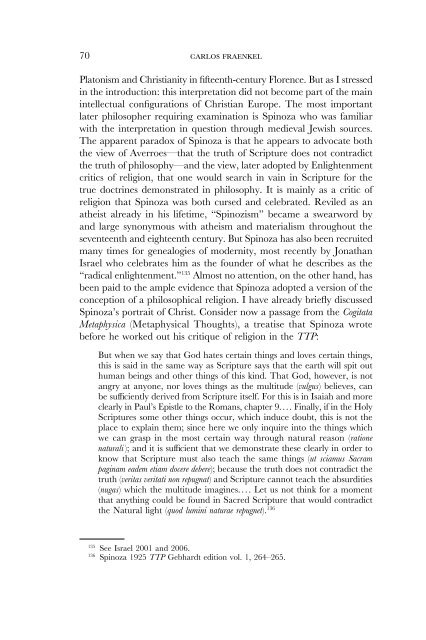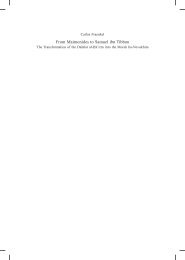Download PDF - Carlos F. Fraenkel
Download PDF - Carlos F. Fraenkel
Download PDF - Carlos F. Fraenkel
You also want an ePaper? Increase the reach of your titles
YUMPU automatically turns print PDFs into web optimized ePapers that Google loves.
70 carlos fraenkelPlatonism and Christianity in fifteenth-century Florence. But as I stressedin the introduction: this interpretation did not become part of the mainintellectual configurations of Christian Europe. The most importantlater philosopher requiring examination is Spinoza who was familiarwith the interpretation in question through medieval Jewish sources.The apparent paradox of Spinoza is that he appears to advocate boththe view of Averroes—that the truth of Scripture does not contradictthe truth of philosophy—and the view, later adopted by Enlightenmentcritics of religion, that one would search in vain in Scripture for thetrue doctrines demonstrated in philosophy. It is mainly as a critic ofreligion that Spinoza was both cursed and celebrated. Reviled as anatheist already in his lifetime, “Spinozism” became a swearword byand large synonymous with atheism and materialism throughout theseventeenth and eighteenth century. But Spinoza has also been recruitedmany times for genealogies of modernity, most recently by JonathanIsrael who celebrates him as the founder of what he describes as the“radical enlightenment.” 135 Almost no attention, on the other hand, hasbeen paid to the ample evidence that Spinoza adopted a version of theconception of a philosophical religion. I have already briefly discussedSpinoza’s portrait of Christ. Consider now a passage from the CogitataMetaphysica (Metaphysical Thoughts), a treatise that Spinoza wrotebefore he worked out his critique of religion in the TTP:But when we say that God hates certain things and loves certain things,this is said in the same way as Scripture says that the earth will spit outhuman beings and other things of this kind. That God, however, is notangry at anyone, nor loves things as the multitude (vulgus) believes, canbe sufficiently derived from Scripture itself. For this is in Isaiah and moreclearly in Paul’s Epistle to the Romans, chapter 9. . . . Finally, if in the HolyScriptures some other things occur, which induce doubt, this is not theplace to explain them; since here we only inquire into the things whichwe can grasp in the most certain way through natural reason (rationenaturali ); and it is sufficient that we demonstrate these clearly in order toknow that Scripture must also teach the same things (ut sciamus Sacrampaginam eadem etiam docere debere); because the truth does not contradict thetruth (veritas veritati non repugnat) and Scripture cannot teach the absurdities(nugas) which the multitude imagines. . . . Let us not think for a momentthat anything could be found in Sacred Scripture that would contradictthe Natural light (quod lumini naturae repugnet). 136135See Israel 2001 and 2006.136Spinoza 1925 TTP Gebhardt edition vol. 1, 264–265.



